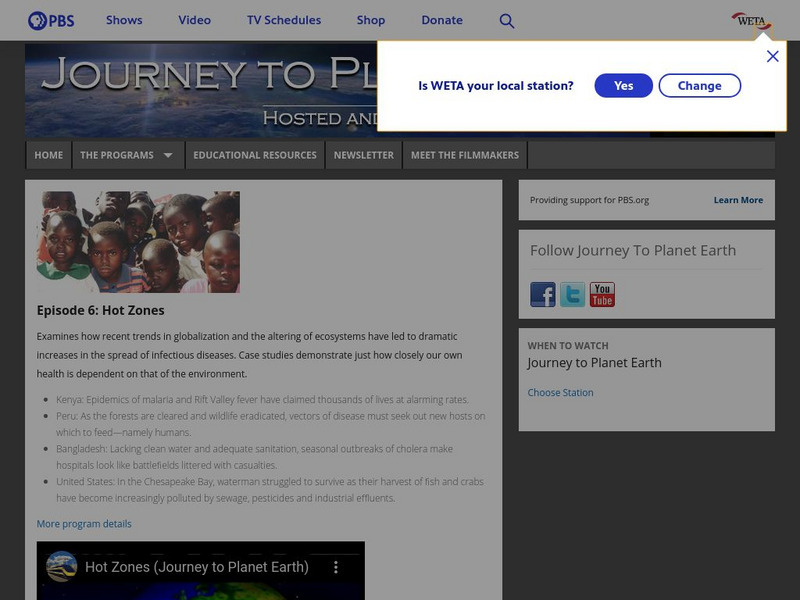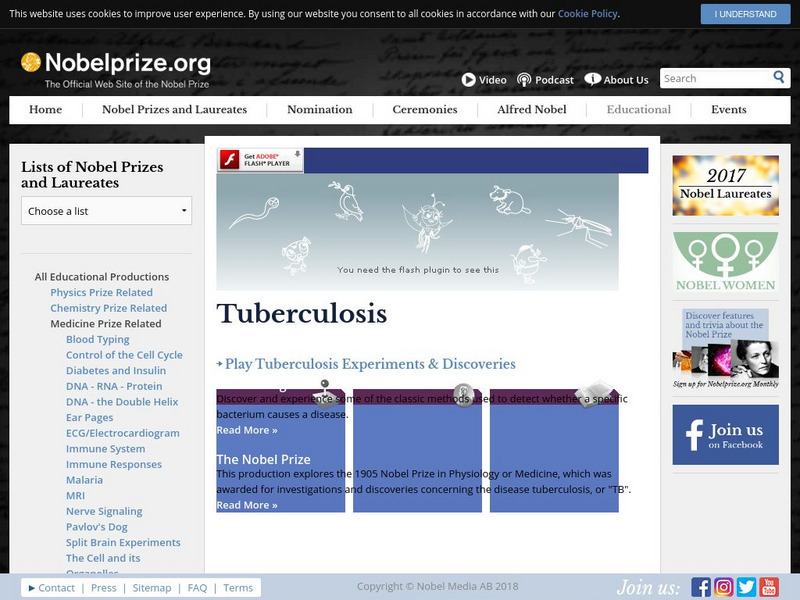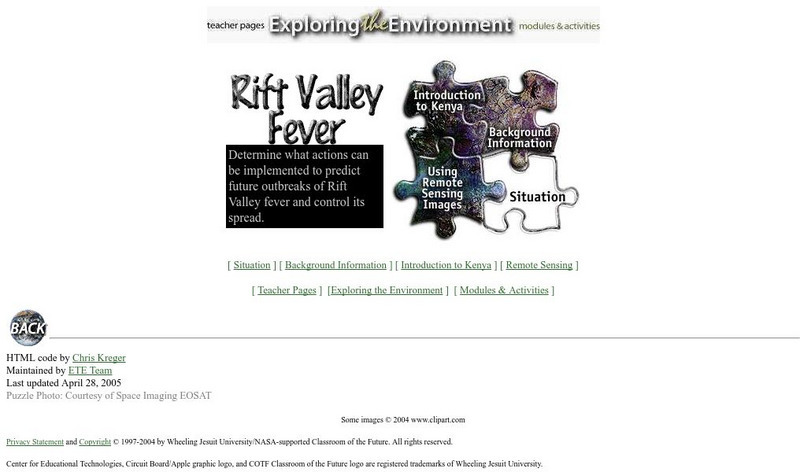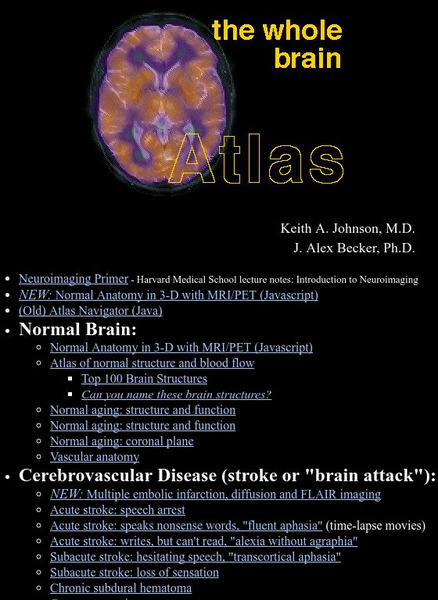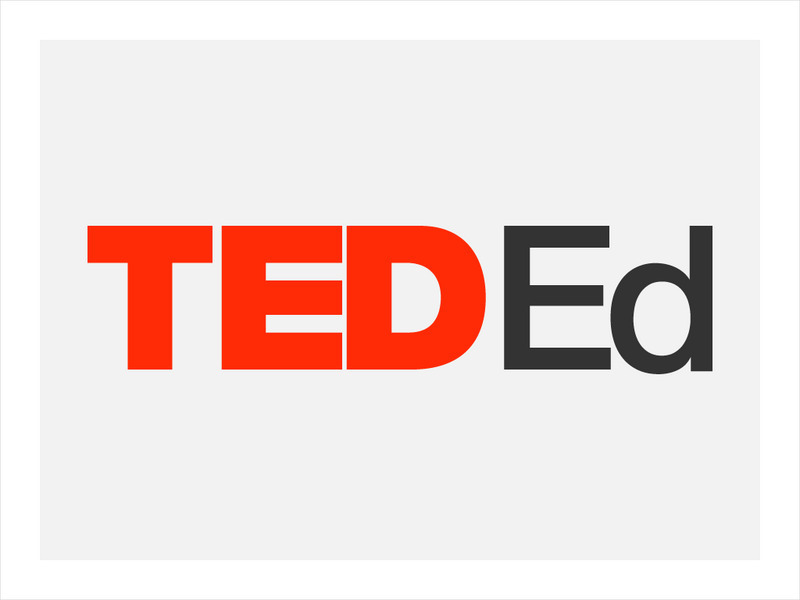PBS
Pbs: Journey to Planet Earth: Hot Zones
This online companion to the PBS series "Journey to Planet Earth: Hot Zones" explores how changes in ecosystems can lead to increased risk and transmission of infectious diseases. Highlights include video clips and educational resources.
Nobel Media AB
The Nobel Prize: Tuberculosis
Play a game to learn how Dr. Robert Koch discovered tuberculosis' cause. You'll "discover and experience some of the classic methods used to detect whether a specific bacterium causes a disease."
Columbia University
The Earth Institute at Columbia University
Bringing people together to discuss Earth's environmental problems, The Earth Institute addresses climate change, environmental degradation, poverty, disease, and sustainable use of resources.
Center for Educational Technologies
Nasa Classroom of the Future: Rift Valley Fever
The Classroom of the Future provides a nice activity integrating many subject areas. Students work in groups to research outbreaks of Rift Valley Fever in Kenya, and determine actions to control and prevent its spread. Background...
WebMD
Web Md: Necrotizing Fasciitis (Flesh Eating Bacteria): Topic Overview
Find out about necrotizing fasciitis, or flesh-eating bacteria, including its symptoms, causes, diagnosis, and treatments.
Khan Academy
Khan Academy: What Is Malaria?
Malaria is an infectious disease caused by a parasite called Plasmodium that invades red blood cells and liver cells. The parasites are transferred to humans by the bite of an infected Anopheles mosquito. The article discusses how...
Khan Academy
Khan Academy: What Is Tuberculosis?
An overview of tuberculosis (TB) or consumption which is an infectious disease caused by bacterium, Mycobacterium tuberculosis. Examined are the affects of tuberculosis on the lungs, latent tuberculosis vs. active tuberculosis, symptoms,...
Khan Academy
Khan Academy: Polio Epidemiology
An overview of the polio as an epidemic prior to 1900 and how the infectious disease has slowly diminished but for three countries (Nigeria, Afghanistan, and Pakistan).
Khan Academy
Khan Academy: What Is Polio?
The infectious disease Poliomyelitis or Polio effects the central nervous system which causes debilitating muscle disorder. Franklin Delano Roosevelt's initial diagnosis of polio is reevaluated as being Guillain-barre syndrome.
Khan Academy
Khan Academy: What Is Polio?
An overview of the infectious disease Poliomyelitis or polio and how it infects the body and its symptoms; polio's affect on the nervous system including the spinal cord and brainstem; diagnosis, treatment, and prevention of polio; and...
Other
Story md.com
Explore the astonishing world of health. Search 36,390 health topics and articles.
Other
Dr. Green: Appropriate Treatment for Scabies
A physician answers the question of what is appropriate treatment for a child with scabies.
CK-12 Foundation
Ck 12: Life Science: Pathogens
[Free Registration/Login may be required to access all resource tools.] Has this ever happened to you? A student sitting next to you in class has a cold. The other student is coughing and sneezing, but you feel fine. Two days later, you...
A&E Television
History.com: How Five of the World's Worst Pandemics Finally Ended
As human civilizations flourished, so did infectious disease. Large numbers of people living in close proximity to each other and to animals, often with poor sanitation and nutrition, provided fertile breeding grounds for disease. And...
Other
Nsf International: Nsf Scrub Club
Keep yourself clean, kill bacteria, and stay healthy all year long by washing your hands (and under your fingernails) with warm soapy water. Play the "6 Steps Game" to learn how to properly clean your hands, meet the "villains" that...
Harvard University
Harvard Medical: The Whole Brain Atlas: Neuroimaging
Hundreds of images of brain structures are here, including normal and diseased brain parts.
Internet History Sourcebooks Project
Fordham University: Modern History Sourcebook: Louis Pasteur
This page presents the text of Louis Pasteur's "Germ Theory and its Applications to Medicine and Surgery" (1878). It provides information about the origin of the germ theory of disease.
National Health Museum
Access Excellence: The Blackout Syndrome
Become a medical investigator trying to solve the cause of a mysterious disease. Through a four-part mystery series, students try to figure out the source of the disease and how to treat it. By reading clues students make predictions and...
Other
H Net: Castorbean History and Connection to Als
This site is a letter from a Graduate Student who believes he has discovered a connection between ALS, otherwise known as Lou Gehrig's Disease, and the Castor bean. The site also provides responses from scholars at various universities...
TED Talks
Ted: Ted Ed: How Pandemics Spread
A discussion about the globalization of disease, and the implications of a pandemic. Mark Honigsbaum describes the history of pandemics and how scientists can help prevent future outbreaks. [8:00]
Science Buddies
Science Buddies: Program Your Own Covid 19 Simulator With Scratch
This activity uses the kid-friendly programming language Scratch to write a simulation that uses bouncing dots to represent healthy and sick people. The simulation will show how we can take measures to slow the spread of a transmissible...
Centers for Disease Control and Prevention
Centers for Disease Control: Infectious Diseases: Tetanus [Pdf]
Brief fact sheet on tetanus includes symptoms and causes.
Centers for Disease Control and Prevention
Centers for Disease Control: Infectious Diseases Cards: Measles [Pdf]
Fact sheet on the measles infection describes its symptoms, as well as how it is contracted and how it is prevented.
Centers for Disease Control and Prevention
Centers for Disease Control: Infectious Diseases Cards: Rubella [Pdf]
Fact sheet on the rubella virus describes its symptoms as well as how it is contracted and how it is prevented.
